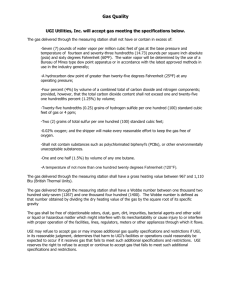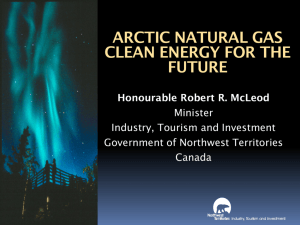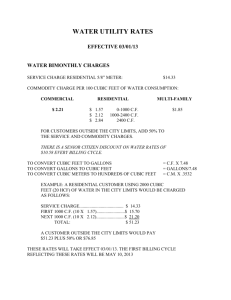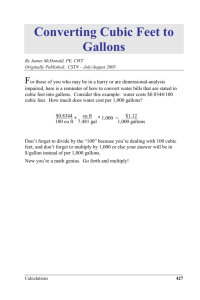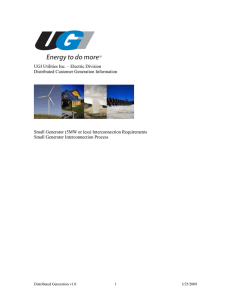What Everyone Needs to Know About Gas
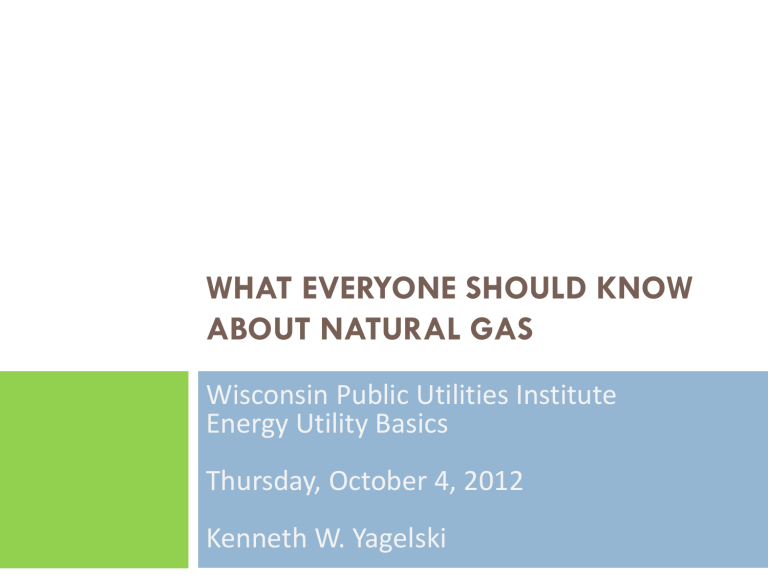
WHAT EVERYONE SHOULD KNOW
ABOUT NATURAL GAS
Wisconsin Public Utilities Institute
Energy Utility Basics
Thursday, October 4, 2012
Kenneth W. Yagelski
About UGI
UGI Corporation (NYSE: UGI), through its subsidiaries, distributes and markets energy products and related services around the world
UGI Utilities distributes natural gas and provides electric service to customers in eastern, northeastern and central Pennsylvania.
UGI Energy Services markets natural gas, propane and electricity to commercial and industrial customers in nine states in the northeast
U.S.
UGI Energy Services owns a variety of assets that support the storage, transportation and delivery of natural gas and electric generation assets in Pennsylvania.
UGI was founded in 1882, bringing 130 years of trusted energyrelated experience to millions of customers
2
Disclaimer
Numeric values are provided for illustrative purposes only and may not represent actual data associated with any specific company.
Processes and strategies are presented for educational and discussion purposes only and are not necessarily intended for implementation in this form.
Numeric values, processes and strategies are subject to change and may not represent the past, current or future plans for any specific company.
Materials represent the opinion of the presenter and not necessarily those of UGI Corporation or UGI Energy Services.
3
What is Natural Gas?
A colorless, shapeless, odorless combustible mixture of hydrocarbon gases that has a relatively high energy content for volume consumed.
About 100,000 British Thermal Units (“BTU”) per one hundred cubic feet of natural gas.
Approximate energy comparisons:
100.0 cubic feet of natural gas
29.31 kilowatt-hours of electricity 1
28.60 pounds of wood
22.20 pounds of garbage
8.30 pounds of coal
0.81 gallons of gasoline
0.72 gallons of diesel fuel
1.09 gallons of propane
4
1 Energy equivalent only. It would require about 200,000 BTU of natural gas to generate the 29.31 kilowatt-hours of electricity.
Natural Gas – Cost Comparison
What is approximate residential delivered energy cost comparison?
100.0 cubic feet of natural gas ~ $ 1.12
2
29.31 kilowatt-hours of electricity ~ $ 3.37
2
28.60 pounds (0.005 cords) of wood ~ $ 3.36
3
22.20 pounds of garbage ~ $ 0.56
8.30 pounds of coal ~ $ 1.38
3
0.81 gallons of gasoline ~ $ 2.94
2
0.72 gallons of diesel fuel ~ $ 2.65
2
1.09 gallons of propane ~ $ 3.03
2
5
2 Energy Information Administration, 3 Various
… But What is Natural Gas?
Image: Government of Alberta, Canada
6
Typical Composition of Natural Gas
Methane
Ethane
CH4
C2H6
70 – 90%
0 – 20%
Propane
Butane
Carbon Dioxide
Oxygen
C3H8
C4H10
CO2
O2
0 – 20%
0 – 20%
0 – 8%
0 – 0.2%
Nitrogen N2
Hydrogen Sulphide H2S
Rare Gases
0 – 5%
0 – 5%
A, He, Ne, Xe Trace
2 U.S. Government, Energy Information Administration, 3 Various
7
Natural Gas Formation Process
Natural gas is formed from the decaying remains of pre-historic plant and animal life.
Most natural gas is formed from the breakdown of prehistoric marine zooplankton.
Natural gas, oil and coal are organic materials that are prevented from complete decay.
Image: American Chemical Society
8
Natural Gas Formation Process
Natural gas is typically found at the top of petroleum reservoirs where it has been formed by the combined action of methanogenic bacteria (bacteria that produce methane while they decompose organic material) and through catagenesis (the thermal decomposition of kerogen).
High temperature and pressure lead to varying degrees of catagenesis and favor the formation of lighter hydrocarbons
(natural gas). Therefore, deeper formations tend to have more gas than petroleum.
Image: Schlumberger Excellence in Educational Development
9
Biogas and Landfill Gas
Methane produced from digested agricultural products (and byproducts) and landfill material decomposition has potential use as a natural gas equivalent. Several significant issues must be resolved before the concept is technically feasible and commercially acceptable.
Technical – Gas quality, grid management, material impact, safety.
Legal – Product liability, emissions, legislation.
Financial – Costs to produce, gather, condition and distribute.
Administrative – Back-office, billing, data management.
Image: Tara’s Treats
10
Natural Gas Discovery
Lightning has been known to ignite natural gas seeping from the earth’s surface, making it a likely early discovery by man.
A famous occurrence was in ancient Greece on Mount
Parnassus ~1,000 B.C. A herdsman found a flame rising from a fissure. The Greeks built a temple on the site that housed a priestess who was known as the Oracle of Delphi. She made prophecies claimed to be inspired by the flame. The site emits various gases to this day.
Image: Crystalinks
11
First Use of Natural Gas
Confucius wrote of wells 100 feet deep yielding water and natural gas along the Tibetan border.
About 500 B.C. the Chinese found places where gas was seeping to the surface. They formed crude pipelines out of bamboo and transported the gas to where it was used to boil sea water, separating the salt and making it drinkable.
12
Image: ChinaVOC and European Geosciences Union
Natural Gas in the Early United States
In 1626 French explorers discovered natives igniting gases that were seeping into and around Lake Erie.
In 1821 William A. Hart dug a 27 foot well in Fredonia, NY to get a larger flow of gas that was already seeping from the ground. He established the Fredonia Gas Light
Company, the first natural gas company in North America.
In 1859 Colonel Edwin Drake was first to dig a well to find natural gas.
Drake hit oil and natural gas at 69 feet. He built a 2 inch diameter pipeline for 5.5 miles from the well to
Titusville, PA.
Image: American Society of Mechanical Engineers
13
Modern Production Regions
Image: Petroleum Geological Conferences Ltd
14
Reservoir Geology
Normal Fault Thrust Fault Pinch-Out
Image: Discovery Drilling Funds
Ancient Reef Anticline Salt Dome
15
Typical Reservoir Material
Image: Department of Energy and Geology.com
Sandstone Shale
16
Typical Reservoir Material – Micro View
Sandstone
Image: Department of Energy and University of Texas Arlington
Shale
17
Production Areas and Pipelines
18
Natural Gas Pipelines
Image: Energy Information Administration
19
Sources of Natural Gas
The United States’ interstate pipeline system provides access to multiple and diverse natural gas production areas and sources.
Approximate breakdown of annual contribution by source:
Domestic production – 24.2 TCF, 88 percent of total
Texas, 29 percent
Wyoming, 10 percent
Louisiana, 10 percent
Oklahoma, 8 percent
Colorado, 7 percent
New Mexico, 6 percent
Arkansas, 4 percent
Imported by pipeline – 3.1 TCF, 11 percent of total
Imported as liquefied natural gas (“LNG”) – 0.3 TCF, 1 percent of total
Source: Energy Information Administration
20
How Much is Available?
The Energy Information Administration (“EIA”) estimate of technically recoverable, proved reserves:
272 trillion cubic feet (“TCF”)
Approximately 97 percent in the Lower 48 states
The EIA estimate of undeveloped, technically recoverable natural gas reserves:
750 TCF
Approximately 63 percent in the Marcellus Shale
Potential Gas Committee estimate of recoverable resources:
1,898 TCF
Don’t confuse reporting differences (i.e. proved, unproved, dry, wet, discovered, undiscovered, etc.). Lack of common approach for reporting makes that very difficult.
21
Where Else is Natural Gas?
Image: United States Geological Survey
22
Where Else is Natural Gas?
Estimates of 1,000 TCF or more. Bans have made exploration difficult.
Image: Institute for Energy Research
23
World-Wide Proven Reserves
3 000
2 500
2 000
1 500
1 000
2 592
1 994
500
0
Middle East Eurasia
494
Africa
Source: Energy Information Administration
430
Asia
344
267
169
North
America
Central and
South
America
Europe
24
Annual Consumption – United States
15
10
5
0
25
20
Source: Energy Information Administration
25
Uses for Natural Gas
Natural gas is used as an energy source in the production of steel, glass, paper, textiles, building materials, and electricity.
Natural gas is also an essential raw material (feedstock) for many common products, such as paint, fertilizer, plastic, antifreeze, dye, photographic film, medicine, and explosives.
More than half of the homes in the
United States use natural gas as their main heating fuel.
Natural gas is also used in homes to fuel cooking ovens and stoves, water heaters, clothes dryers, and other household appliances.
26
Uses for Natural Gas – Changes Over Time
For most of the 1800s, natural gas was primarily used as a fuel for outdoor lamps.
There were few pipelines built to bring gas into individual buildings, so most of the gas went to light city streets. After the 1890s, cities began using electricity for their streetlights so gas producers began searching for new uses for their product.
27
3 000
2 500
2 000
1 500
1 000
500
0
Monthly Consumption – United States
United States Natural Gas Consumption – 2011
Plant Use Pipe Fuel Residential Commercial Industrial Vehicle Power
Source: Energy Information Administration
28
Annual Consumption – United States
0%
24%
2001
5%
3%
21%
14%
33%
Plant Use
Pipe Fuel
Residential
Commercial
Industrial
Vehicle
Power
0%
31%
2011
6%
3%
19%
13%
28%
Source: Energy Information Administration
29
Natural Gas Demand
Coincident Daily Demand for Natural Gas
Budget Demand Actual Demand
30
Natural Gas Demand
Coincident Hourly Demand for Natural Gas
Base Demand Heating Demand
31
Natural Gas Price History
$7
$6
$5
$4
$3
$2
$1
$0
$11
$10
$9
$8
Source: Energy Information Administration
32
Natural Gas Price Forecast
$7
$6
$5
$4
$3
$2
$1
$0
Historical NYMEX
Source: Platt’s Gas Daily
33
Natural Gas Production Cost
$9
$8
$7
$6
$5
$4
$3
$2
$1
$0
12-Month Strip Price ($3.510)
Source: Morgan Stanley
34
Natural Gas Efficiency
Using natural gas results in less total energy consumption.
Electric appliances may consume less site energy than their natural gas counterparts, this disadvantage is more than offset by the greater energy efficiency of the overall natural gas production and delivery system.
In a typical residential application, a natural gas home requires about one-quarter less total energy on a full-fuel-cycle basis than is required for a comparable all-electric home.
This energy efficiency advantage of natural gas-based homes is because less than 10 percent of the natural gas energy produced is used or lost from the point of production to the residence. Whereas, almost 70 percent of the energy produced to satisfy the electricity needs of consumers is used or lost in the process of energy production, conversion, transmission, and distribution.
35
Residential Conservation
70 000 000
60 000 000
50 000 000
40 000 000
30 000 000
20 000 000
10 000 000
0
Number of Customers Annual Consumption
Source: Energy Information Administration
6 000 000
5 000 000
4 000 000
3 000 000
2 000 000
1 000 000
0
36
Natural Gas Efficiency
37
Efficiency Comparison
38
Natural Gas Efficiency – Example
Full fuel cycle assessment for water heating efficiency.
Electric water heater that is 90 percent efficient
(90 percent appliance) x (32 percent fuel) = 29 percent
Natural gas water heater that is 60 percent efficient
(60 percent appliance) x (92 percent fuel) = 55 percent
39
40
For more information please contact:
Ken Yagelski
Manager Midstream Services
UGI Energy Services
202.713.9003
kyagelski@ugies.com
41
